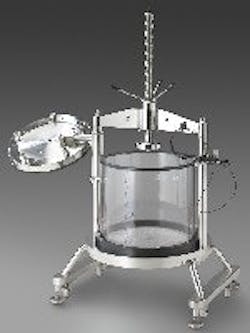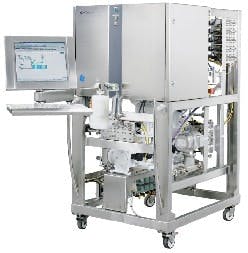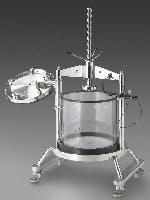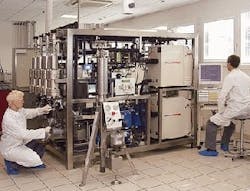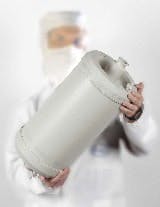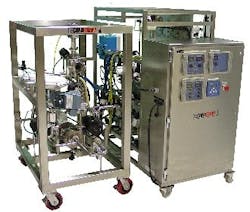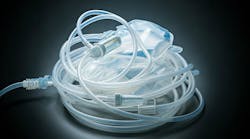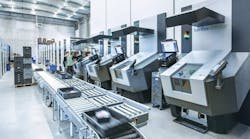By Paul Thomas, Managing Editor
While truly groundbreaking innovations in chromatography equipment happen every blue moon, there have been noteworthy gradual improvements in the areas of chromatography media, column packing and on-line buffer blending, say Howard Levine (president) and Tom Ransohoff (consultant) of BioProcess Technology Consultants (Acton, Mass.).
The need to process large quantities of protein more efficiently, due to larger upstream cell culture titers, has strained downstream processing, and particularly chromatography, Levine and Ransohoff say. The trend has given rise to the need for better flow volumes, binding capacities and control of processes.
While process analytical technologies (PAT) are already being applied to monitor pH, UV and conductivity, the PAT initiative is causing manufacturers to question what more can be done. Can peak-shape analysis be used for batch acceptance or rejection? Can on-line monitoring inform operators about column separation performance? Yes, say Levine and Ransahoff, and in the future more manufacturers will look to PAT for decision-making as well as monitoring assistance. Installed equipment is easily retrofitted to incorporate some of the new elements of PAT, they say.
Membrane adsorbers are gaining traction as well, Levine and Ransahoff note. While they can’t match chromatography media on a cost-per-capacity basis, they have gained acceptance for the removal of contaminants such as nucleic acids, host-cell proteins and product-related impurities. It will take increased capacities before adsorbers make inroads into the capture chromatography market, the two say.
Finally, advances in simulated moving bed (SMB) have spurred interest in small-molecule chromatography, particularly for chiral separations. Chromatography will increasingly be seen as an alternative to crystallization as small molecules become more complex, say Levine and Ransahoff.
All of these trends are reflected in the latest developments among the leading manufacturers of process-scale chromatography systems:
GE Healthcare (Piscataway, N.J.) is continuously developing and expanding its media offerings. MabSelect SuRe, a genetically engineered protein A resin, was introduced late last year as a more durable alternative to protein A that can last 200 to 300 run cycles and cleanings, says Eric Grund, director of Fast Trak Services at GE. A platform process based on MabSelect can be validated and characterized for a range of monoclonal antibody products, says Grund.
The company has also just released Capto S, a cation exchange resin and the third in the high-productivity Capto platform, as well as MacroCap SP, a cation exchanger for handling PEGylated and other very large recombinant proteins.
On the hardware side, GE has just released ÄKTAprocess, a flexible, large-scale chromatography system running GE’s Unicorn software. ÄKTAprocess comes with full regulatory support and wetted parts that are USP class VI, Grund says.
Millipore (Billerica, Mass.) has just introduced a 630-mm version of its QuikScale high-throughput column — the line now runs from 70 to 630 mm in glass, acrylic and stainless steel.
The new, largest QuikScale operates up to 3 bar of pressure, allows the use of all media types, and accommodates a range of linear velocities with minimal pressure differential. Its swing-arm design pivots on a vertical axis for ease of maintenance and operation.
Millipore is now using hydraulics in process-scale columns as a standard to maintain movement and enhance cleanability. The use of hydraulics meets customer demands for more ergonomically friendly production-scale columns, says Stephanie Wilson, global group product manager. To move columns between packing and processing stations, Millipore offers a modified tow truck option.
Novasep, Inc. (Boothwyn, Pa.) is near completion of an advanced control system designed to simplify and shorten development time, particularly for continuous chromatography processes such as simulated moving bed (SMB), which Novasep Process has pioneered for pharma, and Varicol, Novasep's own binary separator that combines cocurrent and countercurrent motion.
The company is also constructing its largest HPLC column to date, says Dan Paradis, sales and marketing manager. The column, expected to be in operation by the end of the year, has an internal diameter of 1600 mm and height of 1200 mm, with an operating pressure up to 70 bar (1015 psi). It has been designed for the purification of recombinant insulin.
Also to be introduced this year, Paradis notes, are production-scale (up to 200-mm-diameter) supercritical fluid chromatography (SFC) systems.
This month, Pall Life Sciences (East Hills, N.Y.) launches two new mixed-mode sorbents, HEA and PPA HyperCel, new selectivities based upon the company's HyperCel matrix. The products exhibit both hydrophobic and ion-exchange characteristics, enabling process chromatographers to bind proteins under gentle, neutral conditions — if necessary, without adding lyotrophic salts, says Russell Jones, Pall's chromatography marketing manager.
Pall is also seeing customers expand applications of its Mustang membrane chromatography line. "Manufacturers are starting to use membrane adsorbers not only for polishing downstream, but also further upstream in the capture steps," Jones says. Membrane adsorbers are being used to protect high-value chromatography media by removing increasing amounts of endotoxins, viral contaminants, and chromosomal DNA debris that may result from the higher protein titers being seen upstream.
Sartorius AG (Goettingen, Germany) continues to be at the forefront of membrane chromatography with its Sartobind line. The company has increased the loading capacity of Sartobind Q for MAb polishing — 10.9 kg MAb per liter sorbent, says Jeff Mora, product manager for membrane chromatography. This allows just one to two liters of Sartobind to clear contaminants and viruses from a 15,000-liter MAb production run. A 1- or 2-liter membrane is approximately 200 times smaller than a column for the same unit operation, and the membrane can process five to 10 times faster, Mora says.
The smaller sorbent volume means 95% less buffer consumption, and thus cost savings. As with other disposables, Sartobind SingleSep Q capsules are disposable and carry no cleaning validation or initial hardware costs, says Mora.
Seika Corporation of America (Bethlehem, Pa.) began distributing YMC Co. (Kyoto, Japan) HPLC production-scale chromatography products in the U.S. last year. Custom production systems include pumping skids, sample loading devices, detection, fraction collection and software, says Seika president Ernest Sobkow. It also has dynamic axial compression systems (column and options) from Kyoto Chromato (Kyoto, Japan) in diameters ranging from 5 to 60 cm and lengths of 70 and 100 cm.
On the biochromatography side, Seika is positioning three different flow rate ranges for isocratic and gradient skids. The systems may be sold with production-scale glass columns from KronLab (Dinslaken, Germany).
TechniKrom (Evanston, Ill.) has been packaging its downstream chromatography equipment with its patent-pending Adaptive PAT control package, which promises to reduce variability in purification processes by tightly monitoring and controlling feedstock make-up and blending. The company believes it can save manufacturers millions through such process optimization. The problem has been that drug makers have always been reluctant to dismiss their legacy validated equipment.
TechniKrom has shifted focus and now offers what it labels an Adaptive PAT Upgrade Module to enhance any installed chromatography base manufacturers may have. "Our clients have always said, 'We can't just throw all this (existing) equipment away,' " says president Lou Bellafiore. TechniKrom's PAT Upgrade Module, a front-end unit that conditions mobile phase components, "can make any system from any manufacturer more precise and nonvariable," Bellafiore says. Bristol-Myers Squibb and other major manufacturers have taken TechniKrom up on its offer.
The PAT Upgrade Module is also being used as a buffer dilution system to provide an immediate expansion in buffer make-up and storage for large-scale downstream processing. Manufacturers can put up to a 10X concentrate in their existing tanks or disposable bags, and achieve a ten-fold increase in capacity, Bellafiore says.
In the SMB (simulated moving bed) arena, TechniKrom has partnered with Knauer (Berlin) to offer a full line of SMB equipment, from lab scale (Knauer) through production scale (TechniKrom).
